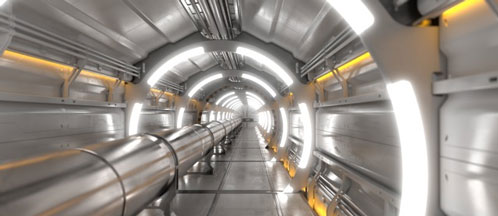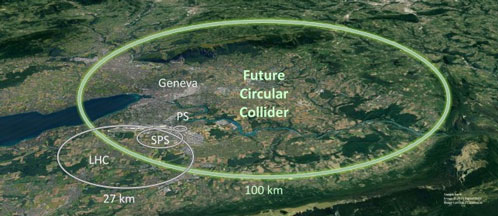15th January 2019 - Over the next two years, the particle physics community will be updating the European Strategy for Particle Physics, outlining the future of the discipline beyond the horizon of the Large Hadron Collider (LHC). The roadmap for the future should, in particular, lead to crucial choices for research and development in the coming years, ultimately with a view to building the particle accelerator that will succeed the LHC and will be able to significantly expand our knowledge of matter and the universe. The new CDR contributes to the European Strategy. The possibility of a future circular collider will be examined during the strategy process, together with the other post-LHC collider option at CERN, the CLIC linear collider.
The FCC study started in 2014 and stems directly from the previous update of the European Strategy, approved in May 2013, which recommended that design and feasibility studies be conducted in order for Europe "to be in a position to propose an ambitious post-LHC accelerator project at CERN by the time of the next Strategy update". The FCC would provide electron-positron, proton-proton and ion-ion collisions at unprecedented energies and intensities, with the possibility of electron-proton and electron-ion collisions.
The FCC design study has been a huge effort, possible only thanks to a large international collaboration. Over five years and with the strong support of the European Commission through the Horizon 2020 programme, the FCC collaboration involved more than 1300 contributors from 150 universities, research institutes and industrial partners (including the ALBA Synchrotron) who have actively participated in the design effort and the R&D of new technologies to prepare for the sustainable deployment and efficient operation of a possible future circular collider.
Using new-generation high-field superconducting magnets, the FCC proton collider would offer a wide range of new physics opportunities. Reaching energies of 100 TeV and beyond would allow precise studies of how a Higgs particle interacts with another Higgs particle, and thorough exploration of the role of the electroweak symmetry breaking in the history of our universe. It would also allow us to access unprecedented energy scales, looking for new massive particles, with multiple opportunities for great discoveries. In addition, it would also collide heavy ions, sustaining a rich heavy-ion physics programme to study the state of matter in the early universe.
The cost of a large circular electron-positron collider would be in the 9-billion-euro range, including 5 billion euros for the civil engineering work for a 100-kilometre tunnel. This collider would serve the worldwide physics community for 15 to 20 years. The physics programme could start by 2040 at the end of the High-Luminosity LHC. The cost estimate for a superconducting proton machine that would afterwards use the same tunnel is around 15 billion euros. This machine could start operation in the late 2050s.
Link to press release: https://fcc.web.cern.ch/Pages/news/FCC-publishes-concept-design-for-a-post-LHC-future-circular-collider-at-CERN.aspx
CDR to be publicly available here: https://fcc-cdr.web.cern.ch/
More information: http://fcc.web.cern.ch/






